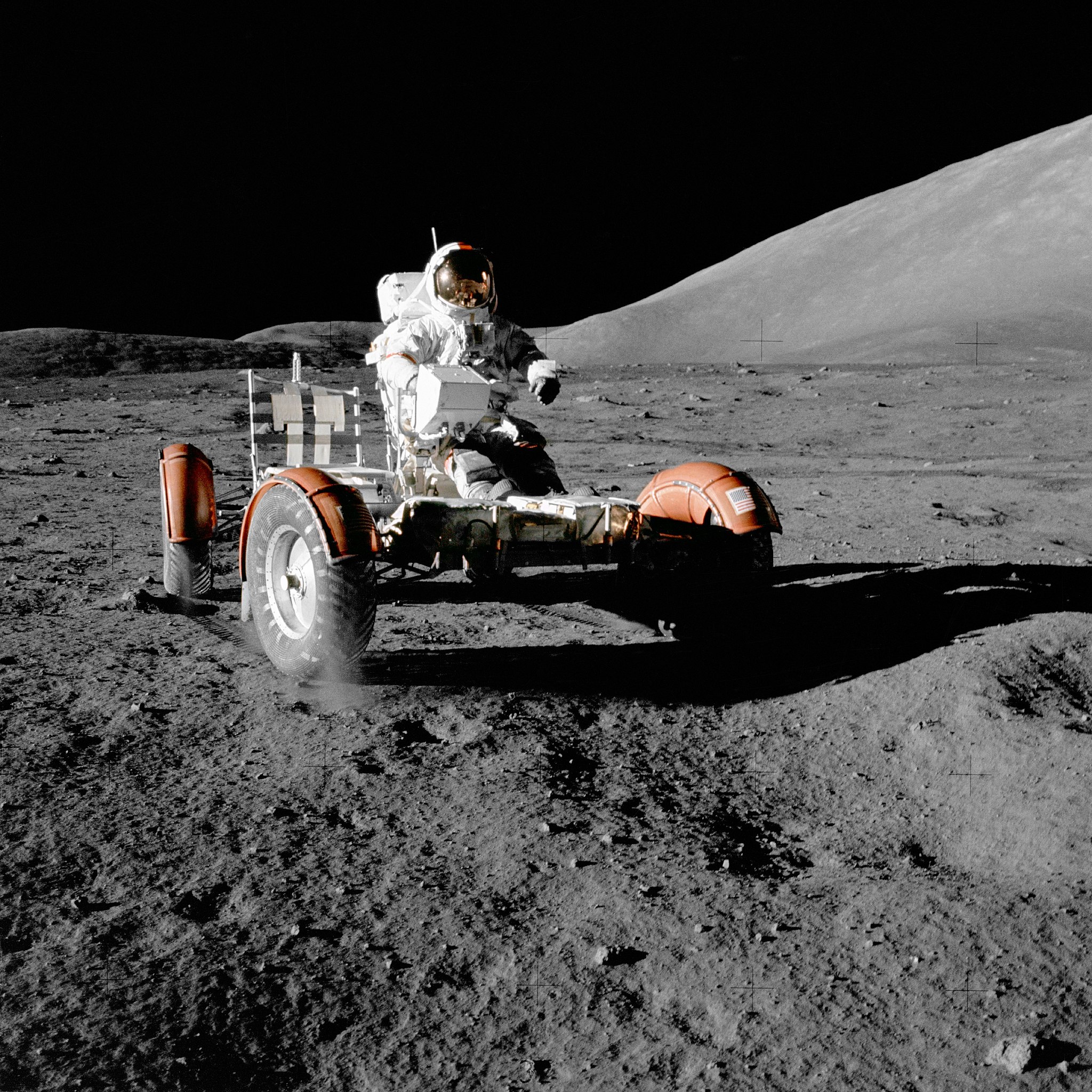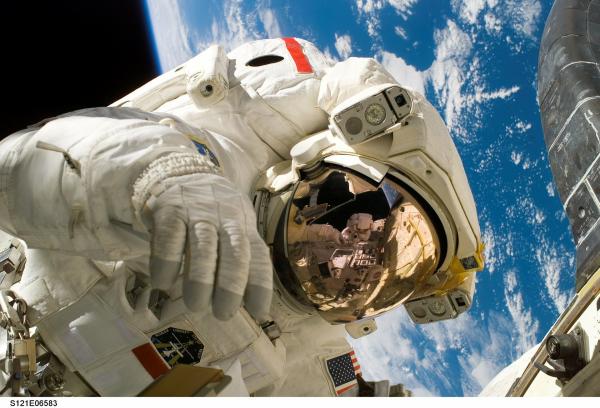Those of us living on Earth are in a privileged location with regards to radiation. Space’s radiation environment includes charged particles from the Sun and elsewhere in the galaxy and high-energy photons in the form of x-rays, UV, and gamma radiation. But we see virtually none of that at the surface of our planet – the Earth’s magnetic field envelopes our planet, diverting the charged particles. The van Allen belts are like two nested donuts, one filled with positively charged particles and the other filled with electrons and other particles with a negative charge. Photons lacking an electrical charge are not affected by our magnetic field, but their intensity is reduced by a factor of over a billion as they plow through the 100 km of our atmosphere.
After leaving our atmosphere, the X-rays, gamma rays, and the Sun’s ultraviolet are unattenuated. But these are not very damaging, and they’re relatively easy to control – more critical and more problematic (not to mention much more interesting) are the high-energy particles from the Sun and beyond the Solar System.
Particles from the Sun
The Sun emits thousands of tons of gas every second – the solar wind. This “wind” consists of ionized gas – mostly protons, electrons, and helium nuclei. According to NASA, the solar wind involves about 400 million protons, moving at 400 km/second, passing through every square cm of the space near Earth every second. The proton’s speed seems fast, but its “negligible” weight means they have little energy, and such particles can penetrate only a relatively short distance into matter. This is the primary reason why charged particles from the Sun cannot penetrate to the Earth’s surface and why the Sun provides very little sea-level radiation exposure.
 In space, outside the protection of Earth’s magnetic field, solar charged particles are a bigger concern. High-energy solar flares (containing photons) or coronal mass ejections (containing charged particles) directed toward the spacecraft pose the greatest risk. In such cases, the crew can receive a fatal dose of radiation in a short time unless they can shelter in a “storm cellar” surrounded by water, plastic, or other forms of radiation shielding.
In space, outside the protection of Earth’s magnetic field, solar charged particles are a bigger concern. High-energy solar flares (containing photons) or coronal mass ejections (containing charged particles) directed toward the spacecraft pose the greatest risk. In such cases, the crew can receive a fatal dose of radiation in a short time unless they can shelter in a “storm cellar” surrounded by water, plastic, or other forms of radiation shielding.
Particles from other stars
The highest cosmic radiation dose to the Earthbound is from heavy ions blasted off from exploding stars elsewhere in our galaxy. This sounds improbable – except that scientists have found “live” radioactive iron and heavy isotopes of plutonium in deep-sea sediments that could only have been synthesized in a supernova. These supernova particles tend to have a higher mass and electrical charge, making them far more damaging to human tissue. Luckily, our astronauts don’t necessarily have to worry about a wave of supernova-produced high-energy particles slamming unexpectedly into their spacecraft; the galactic magnetic field and the great distance make this highly improbable.
Radiation damage from particles
The effect of heavier particles, those that astronauts are likely to experience, are not well understood. An iron nucleus passing through the body, for example, is likely to deliver its high energy to only a handful of cells and none to neighboring cells. On the other hand, an iron nucleus that strikes an atom in a spaceship's skin can splinter into smaller pieces emerging like a shotgun spray of particles rather than the single particle that struck the spacecraft. This small shower of high-mass charged particles, each of which can damage a handful of cells, can cause more damage and risk of future cancer.
What we don’t know
Each type of tissue in the human body reacts differently to radiation exposure; our central nervous system is remarkably resistant to radiation, while the cells that line our stomachs are quite sensitive. We have a reasonably good understanding of how DNA is damaged by beta and gamma radiation and how the body repairs it. But when it comes to understanding the damage caused by an iron nucleus blasted out of a dying star by unimaginable forces, we’re not quite as certain.
The nearest analog is an alpha particle, but alphas are much lighter and cannot penetrate through nearly as much tissue. And, of course, we have never seen humans who have been exposed to the full brunt of a coronal mass ejection or a high-energy solar flare. Even with a shielded “storm cellar” in which to take refuge, we simply don’t know if there might be unanticipated effects.
Radiation dose limits
One thing that we can and have done to mitigate the risks of travel beyond Earth’s magnetic field is to assign dose limits to astronauts the same as we do to workers at hospitals, nuclear power plants, and other jobs involving radiation exposure. NASA’s limits for astronauts are quite a bit higher than for Earthbound radiation workers and change over one’s career to account for an increased number of years in space as well as a lower risk of developing cancer from radiation exposure as we age. [1]
With long-haul space flights apparently on the horizon, NASA is contemplating raising these dose limits to allow their more experienced astronauts to participate and benefit long-duration missions. The question is, what’s a reasonable dose limit that balances omitting a valuable crew member with putting that crew member at risk of developing cancer? The National Academies of Science is currently studying this at the request of NASA.
Putting risks in perspective
There’s one other factor to consider as well – what exposure risk astronauts are willing to accept. About a decade or so ago, when baseball was embroiled in a steroid controversy, the Tour de France suffering another doping scandal, and aspersions were cast upon several Olympics sports, I was listening to an interview with an Olympic athlete. The interviewer mentioned all of the adverse health effects associated with the use of performance-enhancing drugs and asked if the athlete was aware of the risks he was taking. The athlete replied that he was – but that if it improved his chances of winning Olympic Gold, it would be worth it.
Those of us who are not Olympic athletes might question his judgment – not to mention the ethics of doping. We cannot doubt that the athlete was fully aware of the risks and found them acceptable to achieve something hugely important to him. Similarly, for an astronaut facing the challenge and dreams of a lifetime, the risks from radiation exposure en route to Mars and back are also likely to be acceptable.
This shouldn’t surprise us – risk has always attended exploration, yet there have always been explorers. Exploration, by definition, launches one into the unknown to see what’s there. A prudent explorer does what they can to minimize the risks, but they know that risks may not be contemplated and cannot be banished. While exposure to high-mass, high-energy cosmic rays is a bit different from uncharted reefs, being becalmed, or fleeing a hungry predator, the decision-making remains the same – is the astronaut willing to accept the risk, knowing what it means, in exchange for being able to make the trip.
[1] In particular, a male astronaut just beginning his career will not be permitted to receive more than 150 rem of cumulative radiation exposure. Over the following decades, his allowable lifetime exposure will increase to 250 and as much as 400 rem of cumulative exposure if he continues going into space until age 55. Women have similar limits, albeit somewhat lower, to account for some tissues' greater sensitivity to radiation exposure.



